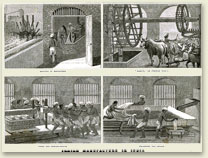| Colorants & dyes Coloring, dyeing and devil's colors Choosing the color of one's garments in Middle Ages before the advent of synthetic dyes, was more a question of money than a question of taste. Unlike other rare and expensive colors such as purpur, blue color was readily available. The most important blue dye was the indian indigo or the somewhat less intense and locally available woad. Manufacture of the dye involved fermenting the woad leaves with human urine. The fermentation is facilitated by the presence of alkohol in the mixture. The usual method for the dyers was to drink alkohol and use their alkohol enriched urine for the fermentation process. Pieces of fabric were immersed in the woad bath usually on sundays for at least 12 hours. The blue color became visible after a prolonged contact of the fabric with air. Drunken dyers lying around hanging fabric on mondays gave rise to colloquial german expressions such as "Blauer Montag" (blue monday = stay away from work on monday) and "Blau werden" (get blue = get drunk). Vasco de Gama found a maritime route to Indiain 1498 and brought indigo to Europe. Dyeing with indian indigo was prohibited by law, partly under death penalty, to protect local peasants from foreign competition. German King pronounced indigo in 1654 "devil's color". At the end of the 17th century Elector Friedrich Wilhelm introduced blue uniforms in the prussian military service to further support the peasants. The blue color of the uniforms was also supposed to give serious and orderly impression. The blue of german uniforms was abandoned in WW1 in favour of camouflage colors. The indian indigo prevailed slowly over woad based on its better dyeing properties and was finally legalized in 1737 and the "Devil's Color" became the "King of the Dyes". Red was the color of Nobility during Middle Ages while the dull blue of woad was the color of servants and lower ranks. The shining blue garments dyed with imported indian indigo were initially reserved for French Royals, later it was also used for working clothes. Blue jeans, originally the attire of gold diggers in California are dyed with indigo up to the present days. Finally in 1897 Adolf Bayer discovered and patented a method to produce indigo synthetically. |
|
Wednesday, February 11, 2009
COLORANTS & DYES
Subscribe to:
Post Comments (Atom)

No comments:
Post a Comment